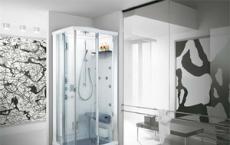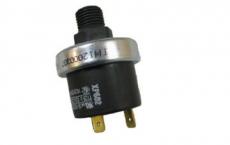Than to warm a coaxial chimney. Coaxial chimneys for gas boilers, photo
The word "co-axial" means finding one object in another. Coaxial chimney is a design for a gas boiler, which allows the pipes to enter each other. It is a two-circuit structure of pipes of different diameters, which are located one in the other. Inside, they are connected by jumpers that do not allow contact. Installed in heat generators with combustion chambers closed type. Such devices include gas boilers, radiators, convectors, etc.
In gas boilers it performs two functions: it serves as the outlet of combustion products to the outside and ensures the supply of clean air, necessary for combustion of gas in the chamber. In boilers with a closed combustion chamber, the length of the pipe, as a rule, is not more than two meters. Often it is paved through the wall into the street. In rare cases, there is a construction, derived through the ceiling and the roof.

Coaxial chimney is a design of two pipes of smaller and larger diameter that enter one another
This is important to know! A coaxial chimney is provided for a horizontal arrangement.
If the location of the supposed output is near the window, it is recommended to do it slightly above the roof. In this case, the vertical part of the installation is also required.
In the standard version, the coaxial type installation consists of the following parts:
- straight pipes;
- cleaning;
- tee;
- condensate collector;
- the knee (with a 90-degree turn angle);
- upper tip.
From the straight pipes the chimney itself is formed, the knee is used to connect the vertical and horizontal parts of it, as well as to connect the horizontal part and the gas boiler.
A set with a horizontal directivity consists of:
- a set of straight pipes;
- lateral tip;
- the knee (with a 90-degree turn angle).
Modern industry produces chimneys of coaxial type for gas boilers of the following range:
- from acid-proof stainless steel;
- stainless steel;
- from the zinced steel.
Chimneys can be manufactured in different combinations, when the inner and outer pipes are made from different types of steel.

Chimney accessories should be standard to avoid gas leakage through slots
About advantages
The main advantage of coaxial chimneys is that the air needed for combustion is received from the outside, and not from inside the premises, such as an oven. For this reason, rooms with a conventional oven need constant airing. A coaxial type chimney operates on a different principle. The combustion product enters the inner tube, while the external one serves to inflow fresh air.
Thanks to this design, several problems are solved that are found in traditional heaters:
- The air coming from outside comes into the room hot, as it heats up from the inner tube, through which passes the hot air saturated with combustion products. Due to this, the heat losses are reduced, and the efficiency heating system, respectively, increases.
- Due to high efficiency, complete combustion of natural gas occurs. Therefore, the particles of unburnt fuel do not enter the atmosphere, do not pollute it, which makes the boiler environmentally friendly.
- It is also important that by giving heat to the outer tube, the inner tube is cooled. This reduces the risk of ignition in the areas of contact between the pipe and flammable surfaces, interior details (wallpaper, plating, etc.).
- The whole process, including the intake of air and the removal of combustion products, takes place in the combustion chamber, which is a closed space. This creates a certain comfort for people, as it eliminates the need to equip the ventilation of the room in case of smoke and carbon monoxide.
- Presented in the widest range, which provides the possibility of their selection for different in power systems.
- Small sizes of coaxial chimneys allow to save space.
The advantages include the ease of installation. A heating system of this type is easy and simple to use and maintain.
Installation of coaxial chimneys
With the advantages of coaxial chimneys one can not but agree, but only if the correct and qualitative installation is made. If the installation works are performed unprofessionally, without observing the technology, its environmental friendliness and safety can be a big question.
This is important to know! Before starting installation, it is necessary to check the presence of chimney parts in the kit, as well as the necessary tools and materials.
For assembly you will need:
- coaxial tube or several pipes;
- smoke exhaust pipe;
- adapter for connection;
- flange on the lining;
- two pads on the walls;
- clamp connecting;
- tip on the pipe.
The chimney is connected to the boiler and taken out of the premises. In the presence of foreign interfering objects they are removed before the removal of the pipe. In addition, it is recommended to free the space around it from highly flammable objects and substances.

The layout of the coaxial chimney must be carefully thought out and meet the installation rules
The installation of the coaxial chimney begins with the selection of the place, including the boiler itself. A gas boiler with a coaxial chimney is recommended to be installed simultaneously. The best option is to place it 1-1.5 meters above the boiler. If necessary, the chimney is lengthened, but so that the knees are not more than two, with a total height of up to 3 meters. Further, as already noted, all unnecessary is removed. Then drill a hole of the required diameter, which can be from 11 to 12.5 cm.
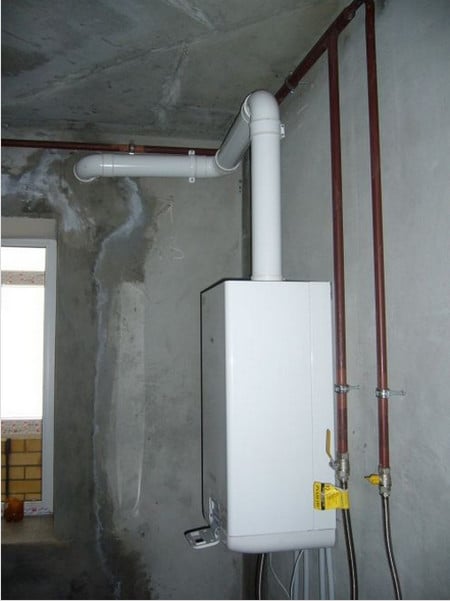
So it looks like a coaxial pipe and a boiler in the room
Further, the pipe is connected to the throat of the boiler by means of a clamp, which is clamped on both sides with bolts. Then, the configuration of the desired configuration is assembled. All parts are connected with clamps. At the chimney, leaving the room, there should be a slight slope for the spontaneous removal of moisture (condensate).
After installation in the right places put on decorative lining, performing an aesthetic function. Lining can be of different shapes, as well as different materials. They are fastened with liquid nails or with the usual construction adhesive. It is recommended to seal the holes with foam, so that there are no gaps that let cool air in and accumulate moisture.
Upon completion of work, it is necessary to check the quality of the entire structure and connecting elements, pay attention to the slope of the pipe for removing smoke and other parts. For maintenance - preventive inspection, cleaning and other actions, the boiler must be switched off, wait for the pipe to cool down, and then carry out the work.
How to insulate coaxial chimneys
What should I do if the chimney freezes? As practice has shown, insulation only helps with the installation of separate pipes, so this option is almost not used in coaxial pipes. The only solution to this problem is to reduce the size of the structure. When the head gets frozen due to the condensate from the pipe with combustion products entering the air intake pipe, the inner tube is shortened relative to the external one.
Safety precautions
When installing the chimney requires compliance with safety regulations, personal protective equipment should be used. Since sharp edges of pipes can cut hands, workers should be in special dense gloves made of cloth or with synthetic material overlays on the palms. To strengthen the nodes it is forbidden to use aluminum tapes, plaster bandages and other similar materials. Insulation must be carried out with refractory silicone.
It is recommended to use materials that have passed state verification. Changes to their configuration and design can not be made. Pipes must comply with current standards, otherwise there is a risk of leakage of exhaust gas and carbon dioxide poisoning due to a mismatch in size. Do not install chimneys over a place where people walk and drive cars, since water can drip from its end and icicles are formed.

When carrying out all work on the installation of the chimney, it is necessary to strictly observe the safety
For violation of the instruction and failure to comply with technological requirements during installation, which led to a breakdown or an accident, the responsibility is borne by the person who performs the installation work or carries out direct supervision. For the qualitative installation of the chimney, it is necessary to invite proven professionals with access to such work.
To install heat generators in the house, working from gas, it is necessary to have certain knowledge and observe all technical conditions. Fulfillment of these requirements will allow the entire heating system of the premises to work stably. Also created a system of chimneys, which will easily remove the gases generated by the combustion of fuel.
In addition, it is necessary to ensure regular supply of fresh air of the required volume, so that it is not consumed from the premises. All these requirements are met by a coaxial chimney for a gas boiler.
What is a coaxial chimney for a gas boiler

The coaxial system of the chimney consists of two pipes of different diameters inserted into each other, with a gap between the walls. This design is great for a gas boiler.
This is the structure of the chimney does not allow air to be expended from the room. Cold air, necessary for fuel combustion in a closed chamber, comes from the street to the outer tube. The combustion products are released by an internal pipe.
Positive aspects of coaxial chimney
Compared to conventional chimneys, coaxial has the following advantages:

Installation requirements
Installing a coaxial chimney is carried out according to and the rules specified in the instructions and technical documentation.
Necessary requirements:
- The pressure of the supplied natural gas should not exceed 0.03 kgf / (0.003 MPa).
- The gas pipeline is installed directly into the room with the heat unit.
- It is allowed to conclude flue gases through the external walls of the house (for boilers with a power of up to 30 kW).
Mounting the coaxial chimney
You can feel the benefits of using a coaxial tube only if you have made a quality and correct installation. If the installation is performed unprofessionally, without observing the necessary technologies, the safety and environmental friendliness of such an assembly will be a big question.
Coaxial chimney: installation and advantages
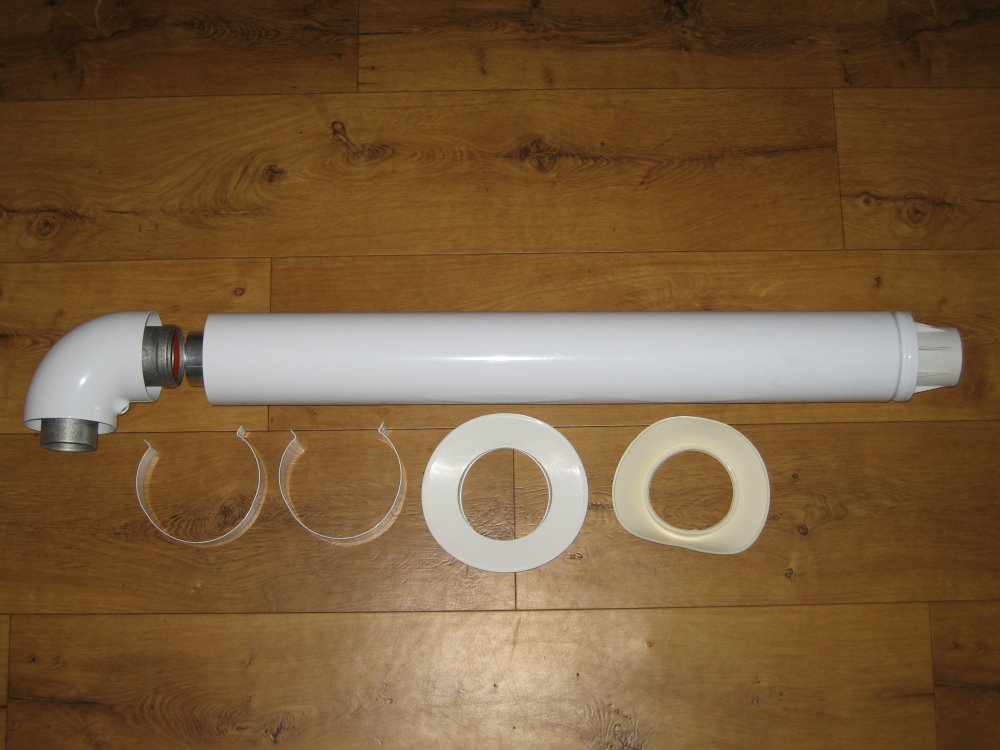

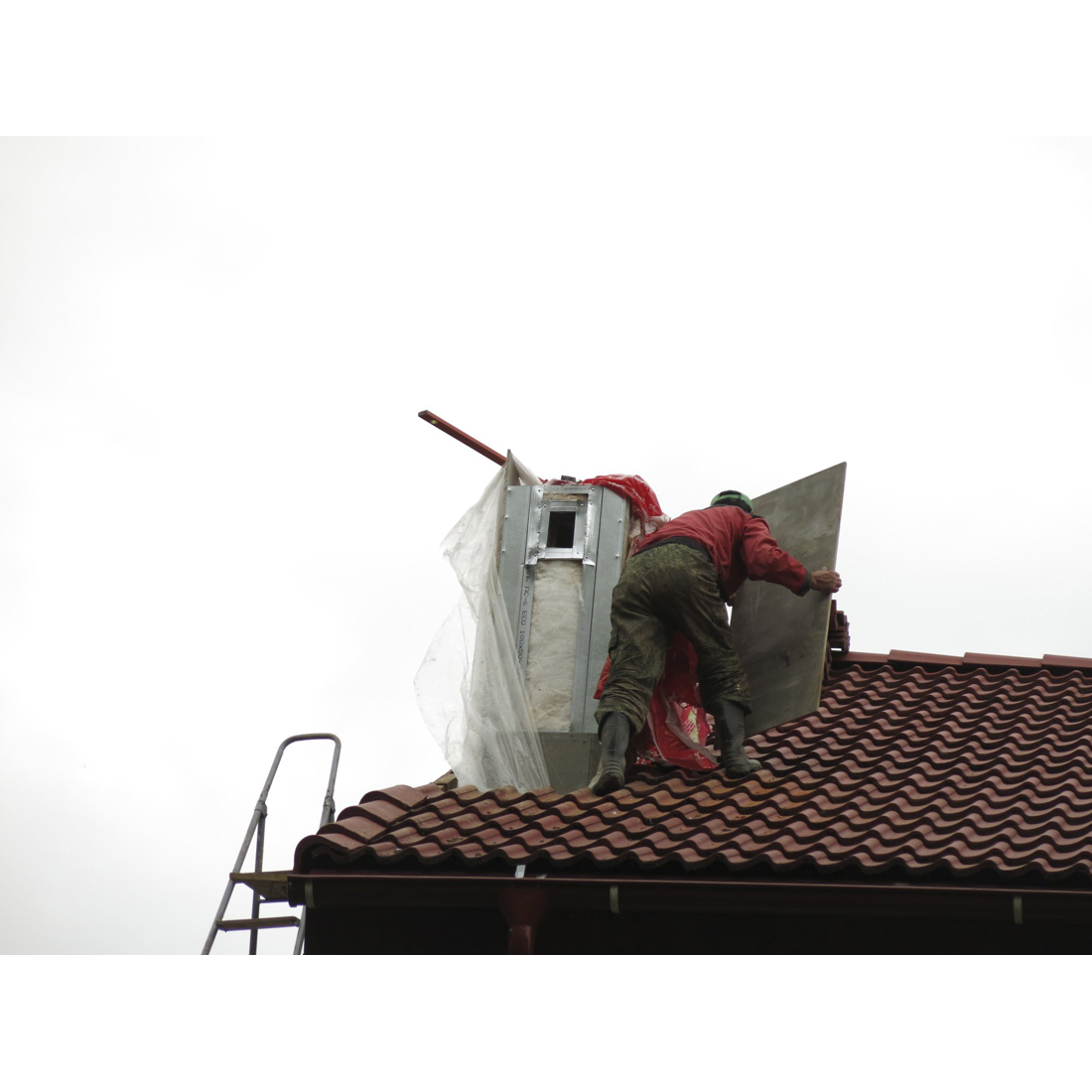

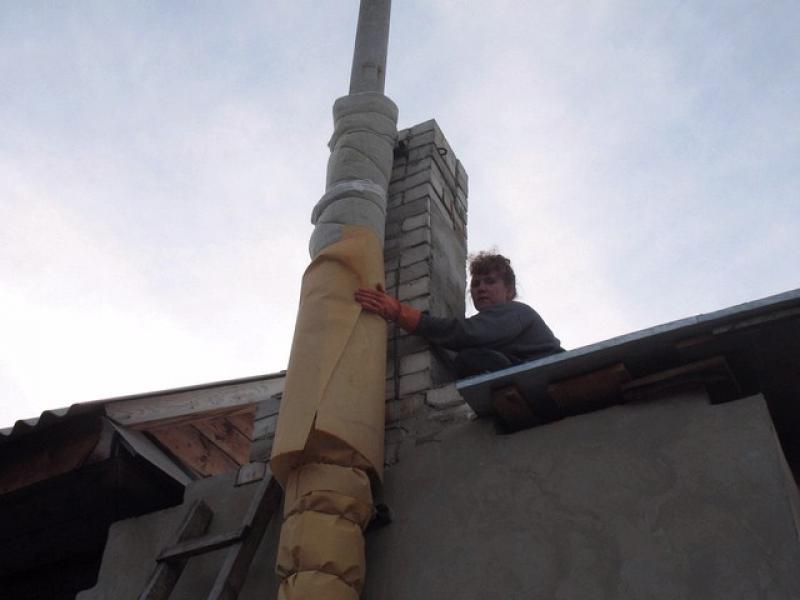
Installation begins with the fact that they make sure that all the chimney has everything necessary parts, and also prepare for work the right tools and materials.
To install a coaxial chimney, you will need:
- Coaxial tube (one or more).
- Pipe for smoke removal.
- Flange.
- Connecting clamp.
- Adapter for connection.
- Two overlays on the walls.
- Tip on the pipe.
Installation follows start by choosing a place. Gas boiler and coaxial chimney must be installed simultaneously. Ideally, the location of the pipe is 1.5 meters above the boiler. If required, you can extend the pipe, but not more than three meters high. Then remove all unnecessary. After that, drill a hole 11 - 12.5 cm in diameter.
Further, with the help of the clamp, the pipe is connected to the throat of the boiler and clamped on both sides with bolts. Then they construct the configuration of such a configuration that is required, connecting details with yokes. If the pipe leaves the room, do it slightly with a slope so that the condensate runs down.
After installing the chimney for the boiler, the hole in the wall should be covered with special decorative pads using liquid nails or building glue. These pads can have a variety of shapes and are made from different materials. The street opening is covered with foam so that cold air does not get into the boiler room and does not create condensation or drafts.
At the end of installation, the chimney for the gas boiler should check on the quality of fastening, on the angle of inclination and other moments.
For inspection and cleaning, the boiler is turned off and waited until the pipe has cooled down, and only then proceed to work.
Do I need to insulate coaxial pipes
If there is severe frost in the street, some sections of the coaxial chimney can freeze, which reduces its effectiveness. To insulate pipes it is necessary that they are separate, and this is not suitable for coaxial chimneys.
The only solution is reduce the size of the structure. If condensate freezes on the chimney head, the inner tube is shortened.
Safety precautions

Installation of the coaxial pipe must be carried out in compliance with safety measures and with the use of personal protective equipment.
Pipes can have sharp edges, and in order not to injure them, special dense tissue gloves should be worn on their hands. You can put on the palm of special pads made of synthetic material. You can not isolate aluminum tapes, gypsum dressings and other similar materials, but only refractory silicone.
For installation and installation, use only those materials that have undergone a state inspection. Nothing can be changed in their configuration and design. Installed pipes must meet the necessary standards. Otherwise, because of the discrepancy in size, there is a possibility of leakage of the exhaust gas, as a result of which it can be poisoned with carbon dioxide.
The chimney should not be installed in a place where people often walk, because in the winter the condensate drains into an icicle and can fall on the head.
Thus, a coaxial chimney for a gas boiler has certain advantages before the usual chimney. If it is properly installed in compliance with all the necessary requirements, then it will work long and efficiently.
Gas fired boilers there are atmospheric (there is a chimney with natural draft) and turbine (there is a coaxial pipe and forced ventilation). In either case, the boiler can stop its work, because under certain conditions it has a freezing temperature gas pipe. Learn how to prevent icing, and what you need to do to prevent such a situation.
Gas boiler with coaxial pipe
Causes of freezing
The cylinder is the most acceptable form of the pipe.
A severe frost and wind, high humidity, falling snow from the roof, improper installation of the pipe and its location in the area of wind pressure can all lead to the fact that the gas pipe of the gas boiler freezes and your mini-boiler room ceases to function.
The main rule when connecting the boiler - do not ignore the recommendations of the manufacturer. Everything is important here: the permissible length of the pipe, its slope and location. The fan not only releases the chamber from the combustion products, it creates the rarefaction necessary to suck in a new portion of air for combustion. Coaxial kits can differ both in the material of manufacture and constructively.
Causes of condensation
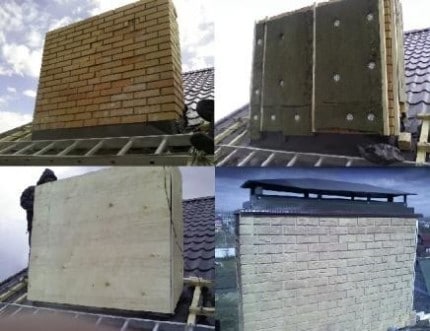
When the chimney is insulated, combustible materials should not be used.
Condensation arises because of the presence of water vapor in the smoke, and its temperature is below the "dew point" temperature (the limiting temperature of the air over the saturation with moisture, above its vapor condenses as droplets).
As the water drops freeze, an ice crust forms, blocking the access of the air necessary to maintain combustion. As a result, the boiler ceases to function. If the gas boiler is installed on the upper floors apartment building, get a terminal (in order to get rid of the ice build-up) is not possible.
How to eliminate icing
The problem can be partially solved by removing the plug (at the top of the boiler). In this case, the flue gases will leave, as before, outside, and the air required for combustion will flow into the system from the room.
When the ice melts, the plug has to be put in its original place, the boiler will not be able to work continuously in this mode. Otherwise, the impurities that are contained in the air (kitchen soot, dust particles) will lead to a breakdown of the unit. If icing does not happen often (1-2 times a year), this method is acceptable. If freezing occurs regularly, you need to purchase a set of "anti-ice".
Varieties of boilers with a chimney
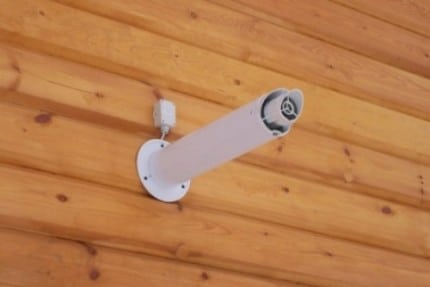
Coaxial gas pipe can freeze under adverse weather conditions due to installation errors.
The role of the chimney is the removal of combustion products. But on how it is designed, depends fuel consumption, and hence, the economy of the boiler. The height of the pipe and the diameter of its section, the material from which the chimney is made and its location - all this has a direct effect on the efficiency of the heating system.
Reducing the efficiency from 95% to 60%, wet walls, carbon monoxide in the room, over-consumption of gas - all this may be due to improper selection and installation of the chimney. When designing, take into account the boiler's power, type of burner, barrel height and temperature of waste gases.
The chimney can be steel, asbestos or brick. Brick well accumulates heat, but it is destroyed after 3 years of operation. Asbestos does not corrode, has insignificant thermal conductivity, serves a long time, but it is not stable due to the physicochemical properties of the material. Steel chimney - the most the best option.
Advantages of stainless steel pipe:
- Inside the pipe is perfectly smooth (brick rough).
- The internal surface of the brick chimney absorbs the substances formed during the combustion of the gas, and the resulting acids destroy the walls of the chimney. In steel pipes, this does not happen.
- It is easier to heat steel pipes than brick ones (you can also buy a pipe with a ready thermal insulation layer).
- The process of purification and removal of condensate is easier to perform in steel pipes. Condensate in the metal chimney is eliminated after 2 minutes, in the brick - after 40 minutes. Continuous contact with water destroys the chimney.
- It is better to install a complex pipe system out of metal, since in this case it is possible to use a connecting mounting material.
In the event that in the already constructed house there is no pipe for flue gas discharge (it was not stipulated by the project), it is possible to build a chimney made of stainless steel.
Options for insulation

Warming of a metal pipe with minimal time and effort. Thermal insulation is placed inside between two pipes.
The main purpose of the chimney insulation - inside should not appear condensate, formed due to the temperature difference inside and outside. In addition, the insulation of the pipe will also protect the roof near the chimney.
Work can be done with the help of such materials: cinder blocks, bricks, mineral wool or slag solution.
Plastering
- Prepared from lime, cement and slag, the solution is applied by a layer of 3 cm onto the reinforced mesh of the chimney.
- When the mixture is a little dry, mineral cotton wool is placed on top of it.
- Again, apply the solution and put the glass net.
- After complete drying of the previous layer, the surface of the pipe is primed and dyed.
Thermal insulation with mineral wool

A warmed chimney reduces the heat loss of the entire heating system.
- The outer surface of the pipe is cleaned.
- Make a lath of profiles. Using a perforator and a screwdriver, drill holes, fix the guides with dowels.
- Then the vertical racks are fastened, securely connecting them to the guides. The distance between them is equal to the thickness of the insulation.
- Mineral cotton wool is densely laid in the crate.
- Using a construction stapler, a polyethylene film is attached from above, the joints are closed with adhesive tape.
- The final stage of work: facing with corrugated board.
For the heat-insulating layer of the asbestos tube, a galvanized casing is mounted. The distance between it and the pipe should be at least 6-8 cm. After laying the insulation (fibrous material, glass wool), the remaining gaps are filled with cement mortar. You can do without a casing at all, but in this case it is impossible to use mineral wool as a heat insulator, and the heat insulation consumption will be twice as much.
Builders also use a metal structure, which can be called a "pipe in the pipe." Free space inside is filled with mineral wool.
The coaxial pipe of the gas boiler will not be covered with ice if it is installed in accordance with the manufacturer's requirements. If the natural gas pipe of a natural gas boiler freezes, it is necessary to insulate the walls of the chimney. This will increase the efficiency of the gas boiler, which means it will make your home warmer and more comfortable.

